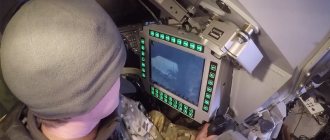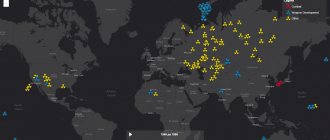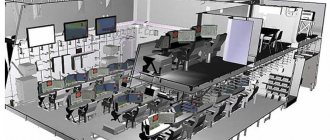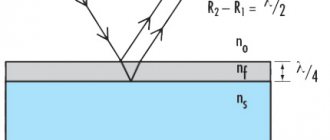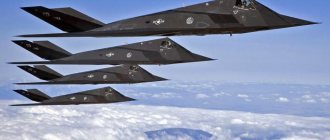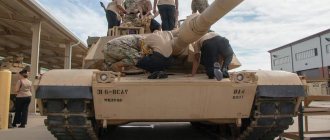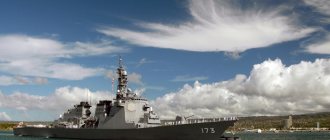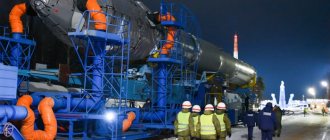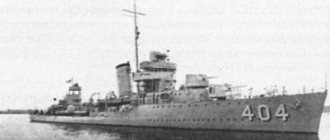American foreign military bases in Google Earth images. Part 3
A very significant number of American military installations are located in the Asia-Pacific region. This primarily applies to South Korea and Japan, where large American military contingents are stationed.
But other countries are not left out of attention either. Thus, approximately halfway between Australia and Vietnam, there is an American naval base in Singapore known as Sembawang Naval Base. Large American warships moor here quite often.
Google Earth satellite image: USS George Washington (CVN-73) parked at Sembawang Naval Base
Sembawang Naval Base was founded by the British in 1923. After the withdrawal of British forces in 1971, she was placed under the control of the Singapore government and was used as a logistics facility for the US, Australian and New Zealand navies. In 1992, an agreement was concluded between the United States and Singapore to station the 73rd Logistics Group of the US Navy's Seventh Fleet, which was withdrawn from the Philippine base of Subic Bay.
American military transport aircraft and air tankers periodically make intermediate landings at two Singapore airfields. In addition, the Singapore Air Force's KC-135R refueling aircraft from Changi Air Base can, if necessary, be used to refuel American military aircraft in the air.
Google Earth satellite image: KC-135R refueling aircraft at Changi Air Base
It is known that in the past, procedures were practiced for refueling American MH-130H aircraft, MH-53 helicopters and MV-22B tiltrotors of the US Special Operations Forces with Singapore Air Force KC-130B tankers from Paya Lebar Air Base.
As of 2014, there were 29,000 American troops in the Republic of Korea. U.S. ground forces in Korea are part of the U.S. Eighth Field Army, headquartered at Yongsan.
Google earth satellite image: Chinhai port
The only American naval base on the Korean Peninsula is the port of Chinhae (Commander Fleet Activities Chinhae). American warships, including those with nuclear power plants, have repeatedly stopped at the base for repairs and maintenance in the past. Currently, the central base of the Republic of Korea Navy is located here.
There are two large American air bases in South Korea: Kunsan Air Base and Osan Air Base. Kunsan Air Base with a concrete runway 2,700 meters long is located in the western part of the Korean Peninsula on the coast of the Yellow Sea, 240 km south of Seoul. The airbase is jointly operated by the United States Air Force and the South Korean Air Force.
Google earth satellite image: Gunsan Air Base
The air base was built during the Korean War and became operational in April 1951. It initially carried A-26 piston bombers and F-84G jet fighter-bombers, later replaced by F-86s. After the incident with the American reconnaissance vessel Pueblo, F-4Ds of the 4th Tactical Fighter Wing settled in Kunsan in January 1968. In September 1974, after the end of the Vietnam War, Phantoms of the 8th Fighter Wing (8 FW) flew here from Ubon Air Base in Thailand. In 1992, the wing was reorganized into the 8th Fighter Wing. Currently, this aviation unit is armed with F-16C/D fighters. The air base is protected from air strikes by a battery of the South Korean Hawk air defense system and an American battery of the Patriot air defense system.
Osang Air Base, located much closer to the demarcation line between the Republic of Korea and the DPRK, is currently home to the F-16C/D and A-10C of the 51st Fighter Wing. The F-16C/D fighter-bombers belong to the 36th Fighter Squadron, and the A-10C attack aircraft belong to the 25th Fighter Squadron.
Satellite image of Google earth: F-16C fighters and A-10C attack aircraft on the runway at Osan airbase
In February 1951, the area of Osang Air Base, located 60 km south of Seoul, was the scene of intense fighting between North Korean and American troops. In 1952, after the runway was repaired, the P-51D piston fighters and F-86 jets began flying combat missions from here. In the late 50s, after the reconstruction of the airfield and the extension of the concrete runway to 2,700 meters, military transport aircraft C-54 and C-119 were based here. In 1968, F-106 interceptors were deployed from the United States. After the withdrawal from Vietnam, aircraft from the 51st Airlift Wing F-4D/E and OV-10, the 19th Tactical Air Support and Surveillance Squadron, were relocated to Osan Air Base. From here, U-2 high-altitude reconnaissance aircraft regularly flew towards the demarcation line with the DPRK.
After the 51st Air Regiment was re-equipped with F-16s, the construction of highly protected concrete shelters for aircraft began at the airbase. This was dictated by the appearance in the DPRK of operational-tactical missile systems created on the basis of Soviet R-17 missiles.
Google earth satellite image: Patriot air defense system at Osan airbase
In 1993, two Patriot air defense missile batteries, part of the 35th Air Defense Brigade, were deployed in the vicinity of the airbase. One of them, with launchers oriented in a northerly direction, is deployed close to the runway.
At the end of 2009, information appeared in the South Korean press that an RQ-170 UAV made using stealth technology was making reconnaissance flights from the Osan airbase in the direction of the DPRK.
At the beginning of 2016, after another round of aggravation of the situation on the Korean Peninsula, an American B-52H strategic bomber flew through the airspace of the Republic of Korea.
Google Earth satellite image: B-52H bombers at Andersen Air Base
This aircraft, capable of carrying nuclear weapons, flew from Andersen Air Force Base on the island of Guam. The territory of the island of Guam, which is the southernmost in the Mariana Islands archipelago, has the status of an unincorporated organized territory (that is, not part of the United States, but being its possession).
The air base on Guam was established in 1944 after the Japanese were driven off the island. Upon completion of the runway, the B-29s of the 314th Bomb Wing were stationed here. In the post-war period, in addition to the B-29, B-36, B-47, B-50 bombers and KV-29 tankers were based at the air base; in the early 60s they were replaced by B-52. Beginning in June 1965, B-52s flying from Guam were used to bomb North Vietnam. Particularly intense bombing was carried out during Operation Linebacker II. It involved more than 150 bombers flying 729 sorties over 11 days. After the fall of South Vietnam, approximately 40,000 refugees passed through Andersen Air Force Base on their way to the United States.
Google Earth satellite image: B-2A bomber at Andersen Air Base
Currently, Andersen Air Force Base, under the control of the 36th Airlift Wing, is used as an intermediate airfield for strategic bombers. There are up to ten B-52s stationed here on an ongoing basis, and the air base is also regularly visited by “stealth” B-2As.
Google Earth satellite image: C-130H military transport aircraft and RQ-4 Global Hawk UAV at Andersen Air Base
In the past, Andersen Air Force Base played an important role as a transit point for the transfer of military cargo and combat aircraft to various parts of the world. In addition to bombers, the air base also has military transport aircraft C-17 and C-130N, as well as flying tankers KS-135R. The air base is currently home to several RQ-4 Global Hawk UAVs flying long-range patrol flights over the Pacific Ocean.
Google Earth satellite image: American nuclear submarines parked at the Guam naval base
In the protruding western part of the island is Naval Base Guam, administratively combined with Andersen Air Force Base. There are 15 multi-purpose nuclear submarines of the US Navy's Seventh Fleet assigned to the base. During combat patrols, Los Angeles-class SSBNs enter the base for urgent repairs, maintenance and crew rest.
Google earth satellite image: warships parked at the Guam naval base
There are also three ocean-class Coast Guard vessels stationed here. Guam is regularly visited by warships from the Australian Navy and the Japanese Maritime Self-Defense Force.
Japan, perhaps, has the highest density of American military installations on its territory among other states. In fact, the country is still under occupation, and a significant part of it is controlled by the American military administration. The reluctance of the US authorities to radically reduce its military presence is explained by the fact that Japan has long turned into an “unsinkable aircraft carrier” and a leading outpost of the American army in the Asia-Pacific region. In addition, the presence of a large American military contingent largely restrains the global political ambitions of the Japanese leadership and allows the Americans to control Japan's domestic and foreign policy.
Approximately 60% of US military installations are located on Okinawa, although this area is only about 1% of the area of the Japanese islands. At the same time, 14 American bases located on an area of 233 square kilometers occupy about 18% of the island’s territory.
Okinawa is home to two major American airfields - Relocation of Marine Corps Air Station Futenma and Kadena Air Base.
Google earth satellite image: CH -53D helicopters at Futenma airbase
The USMC Futenma airbase has a 2,700-meter-long asphalt concrete runway. The airfield was initially used to house B-29 bombers and as a reserve airfield for interceptors from Kadena Air Base.
Google earth satellite image: AN-1 combat helicopters at Futenma airbase
In 1959, it was transferred to the Marine Corps. Since then, A-4 attack aircraft, A/V-8 vertical take-off aircraft, transport and combat helicopters have been stationed here.
Google earth satellite image: MV-22 tiltrotors at Futenma airbase
Since 2009, the air base began replacing CH-46F and CH-53D military transport helicopters with MV-22 tiltrotors. The Osprey combines the vertical take-off and landing capabilities of a helicopter with the cruising speed of a turboprop aircraft.
A few kilometers north of Futenma Air Base is Marine Corps Base Camp Smedley D. Butler. About 3,000 U.S. Marines are stationed in the area.
Satellite image of Google earth: base patrol aircraft R-3C and carrier-based AWACS aircraft E-2C at Naha airfield
South of Futenma Air Base is Naha Airfield. It is divided into two sectors - civilian, where the air terminal is located, and military - shared by the Japan Maritime Self-Defense Force Aviation and the US Navy. In the southern part of Naha Air Base, close to the aircraft parking lot, a battery of Patriot air defense systems is deployed.
Google earth satellite image: Patriot air defense system at Naha airbase
The largest American airbase in Japan, Kadena Air Base, has been operating since July 1945. Soon after the capture of Okinawa by American troops, the construction of an airstrip began here by the engineering service of the 7th Infantry Division of the US Army. From here, before the surrender of Japan, A-26 and B-29 bombers flew combat missions, and they also attacked North Korean targets during the Korean War. F-86 jet fighters from the 18th Fighter Wing arrived here in 1954 and were replaced by F-100s in 1958. Since 1960, Kadena Air Base has been home to the RF-101s of the 15th Tactical Reconnaissance Squadron. In 1968, the Voodoo was replaced by the RF-4C, which served until 1989. In 1979, the first F-15As appeared at the airbase. Currently, the 5th generation F-22A fighters are based here together with the F-15C.
Google earth satellite image: F-22A fighters at Kadena airbase
In addition to fighters, E-3D AWACS aircraft, RC-135 V/W reconnaissance aircraft, KS-135R tankers, S-130N and S-12 military transport aircraft, as well as MS-130 special operations aircraft are also permanently based at the airbase. and basic patrol P-3S.
Satellite image of Google earth: E-3D AWACS aircraft, RC-135 V/W reconnaissance aircraft and KS-135R tankers at Kadena airbase
Google earth satellite image: P-3C base patrol aircraft at Kadena airbase
In 2012, two heavy RQ-4 Global Hawk UAVs were based here to carry out reconnaissance flights in the direction of the DPRK. In November 2006, a battalion of the 31st Anti-Aircraft Brigade, consisting of four batteries of Patriot PAC-3 air defense systems, was relocated from Fort Bliss, Texas to Kadena Air Base.
Google earth satellite image: THAAD missile defense system launchers on Okinawa
In 2012, information appeared about the deployment of the THAAD mobile anti-missile system in Okinawa to protect against North Korean ballistic missiles. THAAD launchers are located in the southeastern part of the island, at the former Hawk air defense missile sites.
To be continued…
Based on materials from: https://sitrep.globalsecurity.org https://www.usfk.mil/ https://www.globalresearch.ca/the-worldwide-network-of-us-military-bases/5564
Or maybe they are hiding it?
But the story doesn't end there. Ufologists and conspiracy theorists could not pass by the Rock Site project. For the US to close something because it's too expensive? Rave! These are clearly stories to divert attention, but in fact, underwater bases were built a long time ago! And of course, they conduct experiments on people there, remove the zombie virus, contact aliens and do all sorts of crazy things.
Many conspiracy theorists like to look for underwater formations and plateaus on Google maps and call them either alien bases or secret government underwater cities.
It would be nice if the Rock Site project really didn’t remain only on the pages of documents. It would become a real monument to the human mind and engineering. Unfortunately, this did not happen.
Or maybe in the future we will see not only underwater bases, but also entire cities?
Joint Defense Space Research Facility Pine Gap, a joint US-Australian base
The military base is located in Australia, but it is also operated by the US military. The object was discovered in early 1970 at a time when humanity was actively beginning to explore space. The base is designed to monitor satellites of other countries and outer space, although experts put forward other versions.
Joint Defense Space Research Facility Pine Gap, Australia
There are 8 giant radars located on the territory of the facility, probably the Australian and US governments are trying to catch signals from other planets. The base can be used to observe UFOs or prevent an attack.
Photos – 13
The construction of one such ship requires approximately 5 billion dollars. By the way, maintaining aircraft carriers is a very labor-intensive job. This requires about 3 thousand workers who daily check all the mechanisms of aircraft carriers, clean, repair, etc. About $10 million is spent monthly from the US budget to maintain such a ship.
Sevastopol Naval Base, Russia
This naval facility cannot be called the largest in the world, but it allows the Russian Federation to control the situation in the Black Sea. Located in the hero city of Sevastopol, it is equipped with several berths in local bays.
Sevastopol Naval Base, Russia
There are many military specialists and equipment at the facility:
- divisions of surface ships;
- minesweepers;
- submarines;
- also divisions of missile, anti-submarine, landing ships and others.
Incidents[edit]
On Easter (April 3), 1988, members of the anti-nuclear group Plowshares boarded the battleship USS Iowa with visitors for a ship tour and left their group to cause symbolic damage to the ship's empty Tomahawk missile launchers, using hammers and their own blood. . [9]
On March 24, 2014, shelling on the NS Norfolk killed a sailor and a civilian. The shooting occurred around 11:20 pm ET aboard the aircraft carrier USS Mahan. Security forces shot and killed a civilian who allegedly shot a sailor on board the ship. [10] The base was closed for a short time after the shooting on the USS Mahan
. [11]
Photos – 3
The base was founded in 1917, and has been constantly expanding since then. Today the base has 10 berths with a total length of 20 km. There are also many ammunition depots and oil storage facilities. There are 6 nuclear-powered aircraft carriers, 5 missile cruisers, 24 missile destroyers and many other types of ships assigned here.

